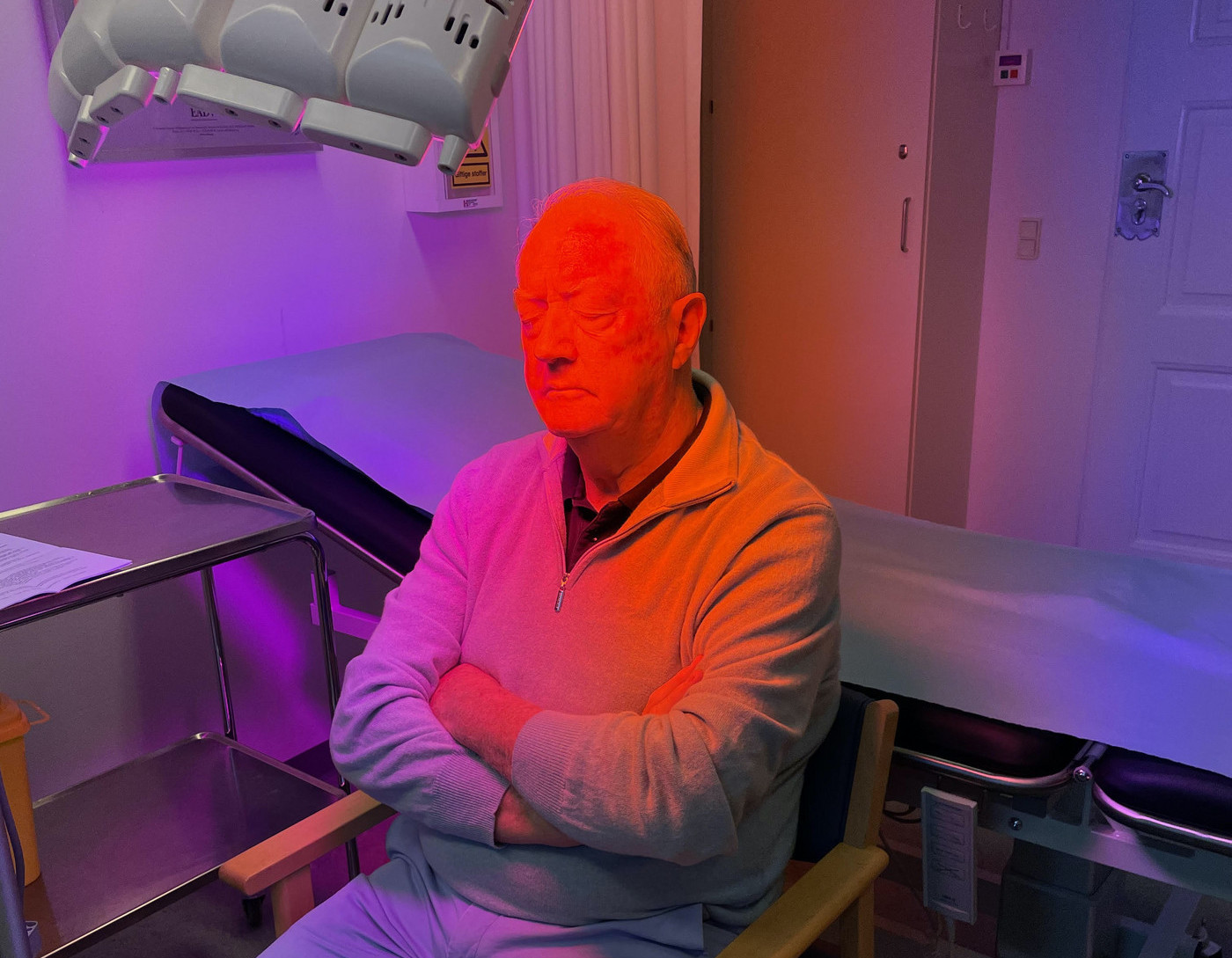Skin cancer treatment
Photodynamic therapy
Photodynamic therapy (PDT) is a treatment for basal cell carcinoma, Bowen’s disease, and actinic keratosis.
After superficial curettage of the skin, a cream containing 5-aminolevulinic acid or methyl aminolevulinate is applied to the tumor or field cancerization.
The uptake in the dysplastic cells creates an accumulation of a photosensitizing substance making the cells sensitive to visible light. When exposed to visible light, the substance is activated, killing the cells in the process.
Conventional PDT
This treatment is used for basal cell carcinomas and Bowen's disease. After three hours of occlusive incubation with the cream, the skin is exposed to red LED light for 7-9 minutes. During illumination, many patients experience some burning in the treated area. The pain can be soothed by cold air/water.
Daylight PDT
Daylight PDT is used for larger areas with multiple actinic keratosis. 30 minutes after applying the cream, the skin is exposed to daylight for 2 hours. Daylight exposure can be performed outdoors with sunscreen protection or indoors using a specialized daylight lamp. In some cases, light is instead delivered in 4 10-minute sessions with a 50-minute pause between each session (fractional PDT treatment). Daylight PDT is not painful during illumination.
After the PDT treatment, redness and swelling will develop in the treatment area, followed by crusting and scaling. The skin will heal within 1-2 weeks. Subsequent use of sun protection is recommended.

Patient receiving daylight PDT treatment.
Existing medical treatments
Topical treatments are medicinal creams used to treat precursors to skin cancer (actinic keratoses and bowel disease), especially when it comes to larger areas of skin.
In some cases, they are also used to treat superficial skin cancers.
5-fluorouracil
An antimetabolite that inhibits the synthesis and function of RNA/DNA. The cream induces cell death in cells that divide rapidly.
Marketed products:
- Creme Tolak 4%
- Cutaneous solution Actikerall 0.5%
Imiquimod
A local immunomodulatory drug that stimulates the formation of cytokines with antitumor effect.
Marketed products:
- Creme Aldara 5%
- Creme Zyclara 3.75%
Diclofenac
An anti-inflammatory drug that probably works by inhibiting cyclooxygenase and angiogenesis.
Marketed product:
- Gel Solaraze
The treatment regimen depends on the ingredient, but often the cream is applied 1-2 times a day for at least 4 weeks.
After 1-2 weeks of use, the treatment induces redness and ulceration. This reaction is intentional but can be quite severe, which is why the cream should only be applied on demarcated areas. Some patients will experience a stronger reaction than intended, and it may be necessary to pause the application.
It may take 2-4 weeks before the skin is fully recovered from the treatment.
Clinical trial on photodynamic therapy pretreated with Flurouracil cream (Tolak)
The patient shows local skin reactions after application of Tolak for 7 days (facial redness on right side).
Curettage
This treatment is performed under local anesthesia and involves superficial scraping of basal cell carcinoma and actinic keratoses. The removed tissue undergoes pathologic evaluation for a diagnosis.
Side effect:
- Hypo-pigmented scarring
Benefits:
- Simple, fast, and in-expensive procedure
Standard Surgery
Conventional surgery is often performed using a local anesthetic. The procedure involves removing the cancer as well as a 3-5 mm border of healthy skin before closing the incision.
The removed tissue is sent to a laboratory where a histopathology report will confirm if all cancerous cells were successfully removed. If any cancerous tissue remains, a follow-up operation is necessary.
Benefits:
- Fast procedure
Mohs Micrographic Surgery
Mohs Micrographic Surgery is recommended for high-risk basal cell carcinoma. The procedure is performed under local anesthesia.
The cancer is removed layer by layer to spare the surrounding healthy skin (no more than 1-2 mm). Each layer is immediately examined under a microscope while the patient waits. The process is repeated until no cancer cells remain and the incision can be closed.
Benefits:
- Complete removal of the skin tumor.
- Healthy tissue is spared.